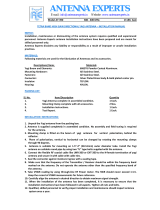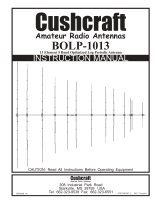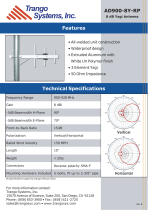Page is loading ...

308 Industrial Park Road
S
tar
k
v
ill
e,
MS
39759
USA Ph: (662) 323-9538 FAX: (662)
Model VB-23FM
2
-
Meter 3
-
Element Beam
[ INSTRUCTION MANUAL
Figure 1
Overall View and Boom Detail
GENERAL DESCRIPTION
SPECIFICATIONS
This two meter beam consists of three elements
mounted on a 43 1/2" boom. The antenna fea-
tures extremely high front-to-back ratio (F/B),
with maximum obtainable gain. The high F/B
is useful in hidden transmitter hunts and for
rejection of unwanted signals. The antenna is
end mounted, giving it the advantage of no
mast decoupling and broad frequency response.
This antenna features stainless steel hardware
for all electrical and most mechanical
connections and includes a boom-to-mast
b
racket for masts 1 5/8" to 2 1/16" O.D.
Mechanical
Boom Length ....................43 1/2" (1105 mm)
Longest Element ............... 40 1/4" (1022 mm)
Net Weight ............................. 2.2 lbs. (1.0 kg)
Turning Radius (max.)...... 43 1/2" (1105 mm)
Wind Survival .................... 80 mph (129 kmp)
Mast Diameter …1 5/8” to 2 1/16" (41-53 mm)
Boom Diameter .............. 1 1/4" O.D. (32 mm)
Wind Area:
Horizontal .............0.395 sq. ft. (0.04 sq. m)
Vertical .................0.446 sq. ft. (0.05 sq. m)

Electrical
Gain (average) ............ 8.3 dBi (6.1 dBd)
Front-to-Back Ratio .................. 20 dB
SWR (max.) ......………..................... 2:1
Band Width ....……..................... 4 MHz
Maximum Power .. 250 watts continuous,
500 watts P.E.P.
Impedance ........... 50 ohms (with balun)
Half-Power Beamwidth ....... 95° (vertical
polarization), 60° (horizontal polarization)
SWR AND FEEDLINE
The 203S-1 antenna has an input
impedance of 200 ohms. The supplied
balun matches the input to 50 ohms. If you
are using a transmission line with a
characteristic impedance other than 50
ohms or 200 ohms, a matching device must
be made. Refer to any current Amateur
Handbook for information on
constructing a matching device.
TUNING
Parasitic Elements: This antenna is
pretuned for maximum gain and best
radiation pattern at 146 MHz. This
setting will give optimum performance
over the entire 144-148 MHz band.
If you wish to optimize the antenna for
a frequency higher than 146 MHz, cut
1/4" off of the total element lengths for
each MHz hi
g
her than 146.
Driven Element: SWR can be lowered
to less than 1.2:1 at a desired frequency
by carefully trimming the driven
element. Keep the element symmetrical
by cutting the same amount from each
side. Typical SWR curves are shown in
Figure 2A and a cutting chart is shown
in Figure 2B. Each installation is
slightly different, so cut the driven
element for the lower SWR at your
particular location. Measure the SWR
as close to the antenna as you can for
accurate results.
NOTE: The Driven and Parasitic Elements
are adjusted independently in the following
manner:
Figure 2A VSWR for Both
Horizontal and Vertical
Polarization
Figure 2B Driven Element
Cutting Chart
Figure 2
VSWR for Both Vertical and Horizontal Polarization

Figure 3 Stacking Two (2)
Ant
e
nn
as
STACKING
This antenna can be easily stacked for
approximately 3 dB more gain each time
the number of yagi is doubled. Refer to
Figure 3 for stacking and phasing harness
cuttin
g
information.
The two phasing lines coming from the
two antennas to the "T" connector can be
any odd multiple of one-quarter
wavelength in the 75 ohm transmission
line. See Figure 4.
NOTE: When phasing two antennas, the
Driven Element halves that are connected
directly to the phasing lines should be on
the same side of the array.
The feedline impedance is for 50 ohms
(RG213/u). For detailed information on
stacking more than two yagis, please
co
n
su
lt
a
n
y
cu
rr
e
nt Am
a
t
eu
r h
a
n
dboo
k
.
Figure 4 Phasing Line Cutting
Dim
e
n
s
i
o
n
s

Item Item
N
o. Descri
p
tion
N
o. Descri
p
tion
1
Boom, 1
1
/4" x 43
1
/2"
21 Lockwasher, internal, 1/4"
4 Boom-to-Mast Clamp 22
N
ut, hex,
1
/4"-20
Back-Up Plate 23
U-bolt,
5
/16" x 2
1
/16" x 3
5
/a"
(ZCI)
13
Caplug, 1
1
/4", black
24 Lockwasher, split, 5/is"
20
Bolt, hex head,
1
/4"-20 x
3
/4"
25
Nut, hex,
5
/16'"-18
F
i
gure 5 Boom-to-Mast Clam
p
Assembl
y
INSTALLATION
This antenna fits a 1
5/8" to 2
1/16" mast. A
2" O.D. pipe is recommended for a sturdy
mast.
WARNING
Do not allow any part of the antenna to
touch power lines. This could cause
severe burns or fatal in
j
uries.
Mount the antenna in the clear.
Surrounding objects, particularly power
lines and other objects of considerable
mass or length are detrimental to the
p
erformance of the antenna.
When mounting two dissimilar antennas
on the same mast, be sure they are
separated by at least six feet - eight to ten
feet is even better.

The antenna can be mounted either
vertically or horizontally for 146-148 MHz
or 144-146 MHz respectively. Circular
polarization can be obtained by using two
yagis. For information about which
polarization is best, consult local Amateurs
who use the frequencies you desire.
STEP-BY-STEP ASSEMBLY
Remove the parts from the carton and
check them against the Parts List and the
illustrations.
Select the R1 (40
1
/4" rod). Use a pencil to
place a mark at the center of the rod
(20
1
/s") from either end. Place two more
marks
5
/8" on each side of the center mark.
Place a #10-24 x 1
1
/2" eyebolt into the R1
slot as shown in Figure 5, Detail A. Slide
the R1 through the holes and the eyebolt
until the outer two marks on the R1 are
visible on each side of the boom. Slip on an
aluminum halfwasher, lockwasher and a
#10 nut. Tighten it just enough to hold the
rod securely.
Select the boom backup plate, the boom-to-
mast bracket and the four (4)
1
/4"-20 x
3/
4"
bolts, lockwashers and nuts.
Select the element-to-boom insulator, two
sections of the Driven Element (DE)
(
7
/16"
x 17
1
/4" tubing) and the beta rod. DO NOT
OVER TIGHTEN.
Place the boom-to-mast bracket on the
boom as shown in Figure 5. Use the
1
/4"-20
x
3
/4
"
bolts in the outside holes. Leave the
inside holes for the two U-bolts, which will
be used later for mounting the mast. Select
either the vertical or horizontal mounting
position. Adjust the boom accordingly
before tightening the bolts securely.
NOTE: If 50 ohm coaxial cable is used to
feed the antenna, select the supplied balun
at this time. Wrap the balun with tape at
three locations as shown in Figure 5, Detail
B.
Use the #10-24 x 2
1
/2"
b
olt to fasten the
element-to-boom insulator to the boom.
Refer to Figure 5, Detail B.
Item
Item
No. Descri
p
tion No. Descri
p
tion
1 Boom
,
1
1/4" x 43 1/2"
14
E
y
ebolt
,
#10-24 x 1 1/2" x
6D1
,
35" x She" 18 Lockwasher
,
internal
,
#10
7
111
,
40'/a" x
3
/16"
19
Nut
,
hex
,
#10-24
11 Half-Washer, aluminum
Figure 5 - Detail A Parasitic
Element Attachment

Use the two (2) #10-24 x 1
1
/4"
b
olts to
assemble the Driven Element as shown in
Figure 5, Detail B. Pay particular attention
to the connections of the beta rod, balun
and feedline.
Waterproof the connection with neoprene
or a silicone type sealing compound.
Install caplugs on the ends of the boom and
the Driven Element.
Use the #10 x
3
/s" screw to fasten the beta
rod shorting clip over the beta rod, as
shown in Fi
g
ure 5
,
Detail B.
Select the D1 (35") and secure to the boom,
using the same procedure as was done with
the R1. The center of the D1 is 17
1
/2" from
either end.
Slip the two (2) U-bolts into the boom-to-
mast bracket and fasten it to the mast
Tape the coax feedline and
b
alun to the
boom and to the mast. Be sure to insulate
any connections from the boom or the
mast. This com
p
letes
y
our installation.
Item
Item
No. Description No. Description
2DE
,
,
/s" x 17'/4" 15 Screw
,
p
an head
,
#10 x
3
/a"
,
T
yp
e
3 Beta Rod, 3" 16 Bolt, hex head, #10-24 x 1
1/2"
8 Insulator
(
DE-to-Boom
)
17 Bolt
,
hex head
,
#10-24 x 2
1
/2"
10 Beta Clip 18 Lockwasher, internal, #10
12 Ca
p
lu
g,
Vc
,
"
,
with hole 19
N
ut
,
hex
,
#10-24
Figure 5 - Detail B Driven Element, Beta Match and
Balun Assembl
y

PARTS LIST
Item
No. Fart No. Descri
p
tion
Q
t
y
1 160039 Boom
,
1 1/4" x 43
1
/2" . . . . . . . . . . . . . . . . . . . . . . . . . . . 1
2 175157 DE
,
7/16" x 17
1
/4" ................................................ 2
3 160040 Beta Rod, 3.................................................... 1
4 385142-1 Boom-to-Mast Clam
p
.......................................... 1
5 385144-1 Back-U
p
Plate................................................. 1
6 160023 1
)
1
,
35" x
3
/16" .................................................. 1
7 160038 R1, 4
0
1/4" x:;/s"................................................. 1
8 465420 Insulator
(
DE-to-boom
)
......................................... 1
9 871704 Balun Assembl
y
............................................... 1
872074-1 Parts Pack 2035-1
,
Stainless Steel .............................. 1
10 163266 Beta Cli
p
.................................................... 1
11 170376 Half-Washer
,
aluminum ...................................... 2
12 475639 Ca
p
lu
g
, with hole ....................................... 2
13 455630 Ca
p
lu
g,
1 1/4"
,
black........................................... 2
14 540065 E
y
ebolt
,
#10-24 x 1
1
/2" x 5/16" .................................. 2
15 510670 Screw
,
p
an head
,
#10 x
3
/8"
,
T
yp
e A ........................... 1
16 500159 Bolt, hex head, #10-24 x 1
1
/2" ................................. 2
17 500164 Bolt
,
hex head
,
#10-24 x 2
1
/2" ................................. 1
18 565697 Lockwasher, internal, #10 ................................... 10
19 554071 Nut, hex, #10-24 ............................................. 9
20 505266 Bolt
,
hex head
,
1
/4"-20 x1/a..................................... 4
21 562961 Lockwasher, internal, 1/" .................................... 5
22 554099 Nut
,
hex
,
1
/4"-20 .............................................. 4
23 540067 U-bolt, -'/6" x 2
1
/6" x TVs"
(
ZCI
)
................................ 2
24 564792 Lockwasher
,
s
p
lit
,
5/16" ....................................... 4
25 555747 Nut, hex, /(i"-18 ............................................. 4
CONVERTING ENGLISH MEASUREMENTS TO METRIC
Use this scale to identif
y
len
g
ths of bolts
,
diameters of tubes
,
etc.. The En
g
lish
0
"
)
an
d
f
oo
t
(
1'
)
c
an
be
co
n
ve
rt
ed
t
o
ce
ntim
e
t
e
r
s
in th
e
f
o
ll
ow
in
g
w
a
y:
1 inch (1") = 2.54
cm 1 foot (1 ')
=3048cm
Example:
42" x 2.54 = 106.7
cm

Hy-Gain Warrants to the original owner of this product, if manufactured by Hy-Gain
and purchased from an authorized dealer or directly from Hy-Gain
to be free from
defects in material and workmanship for a period of 12 months for rotator products and
24 months for antenna products from date of purchase provided the following terms of
this warrant
y
are satisfied.
1. The purchaser must retain the dated proof-of-purchase (bill of sale, canceled check,
credit card or money order receipt, etc.) describing the product to establish the
validity of the warranty claim and submit the original or machine reproduction of
such proof of-purchase to Hy-Gain at the time of warranty service. Hy-Gain
shall
have the discretion to deny warranty without dated proof-of-purchase. Any evidence
of alteration, erasure, or forgery shall be cause to void any and all warranty terms
immediately.
2.
Hy-Gain
agrees to repair or replace at Hy-Gain’s
option without charge to the
original owner any defective product under warranty, provided the product is
returned postage prepaid to Hy-Gain
with a personal check, cashiers check, or
mone
y
order for $8.00 coverin
g
p
osta
g
e and handlin
g
.
3. Under no circumstances is Hy-Gain
liable for consequential damages to
p
erson or
p
ro
p
ert
y
b
y
the use of an
y
H
y
-Gain
p
roducts.
4. Out-of-warranty Service: Hy-Gain
will repair any out-of-warranty product
provided the unit is shipped prepaid. All repaired units will be shipped COD to
the owner. Repair charges will be added to the COD fee unless other
arran
g
ements are made.
5. This warranty is given in lieu of any other warranty expressed or implied.
6.
Hy-Gain
reserves the right to make changes or improvements in design or
manufacture without incurring any obligation to install such changes upon any of
the products previously manufactured.
7. All H
y
-Gain
p
roducts to be serviced in-warrant
y
or out-of-warrant
y
should be
addressed to hy-gain, 308 Industrial Park Road,
Mississippi 39759, USA
and must be accompanied by a letter describing
the problem in detail along with a copy of your dated proof-of-purchase.
8. This warranty gives you specific rights, and you may also have other rights which
vary from state to state.
LIMITED WARRANTY
/









